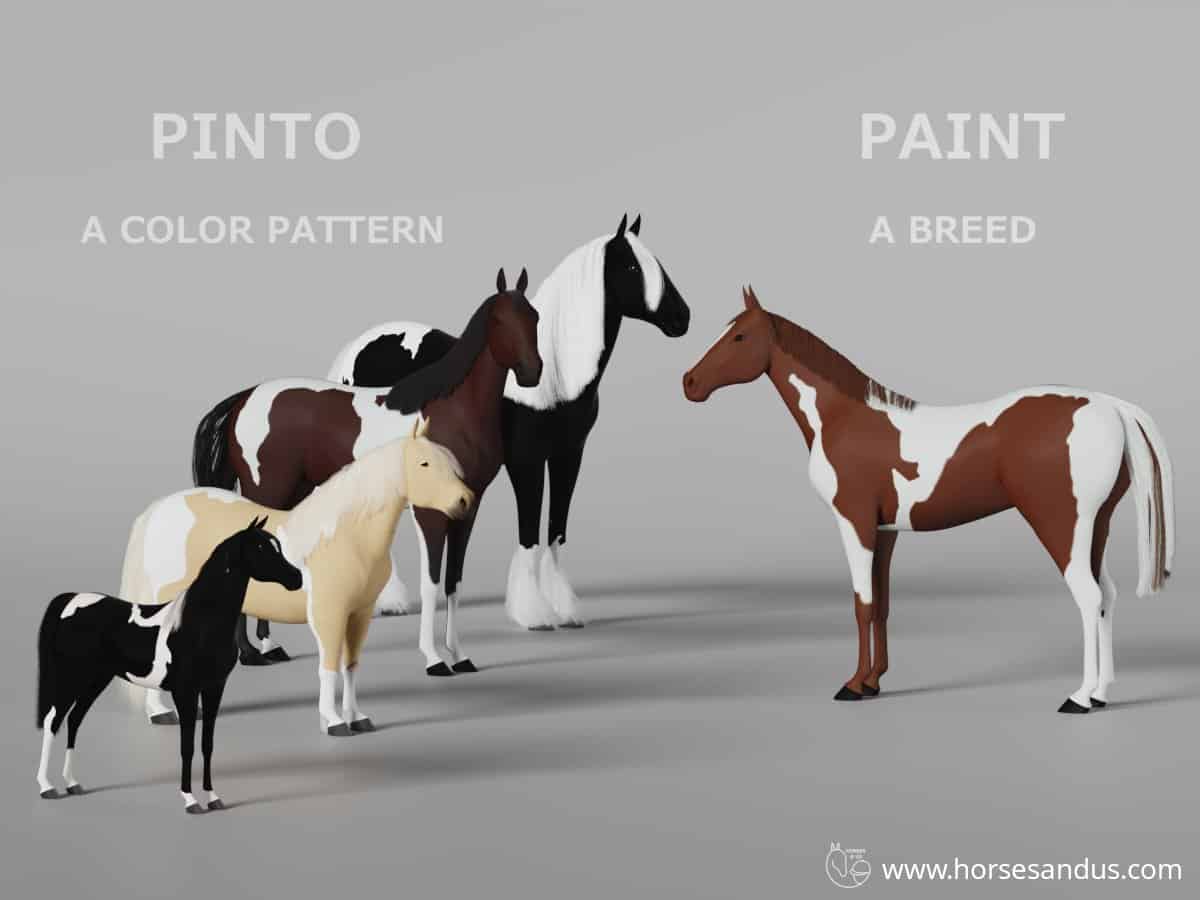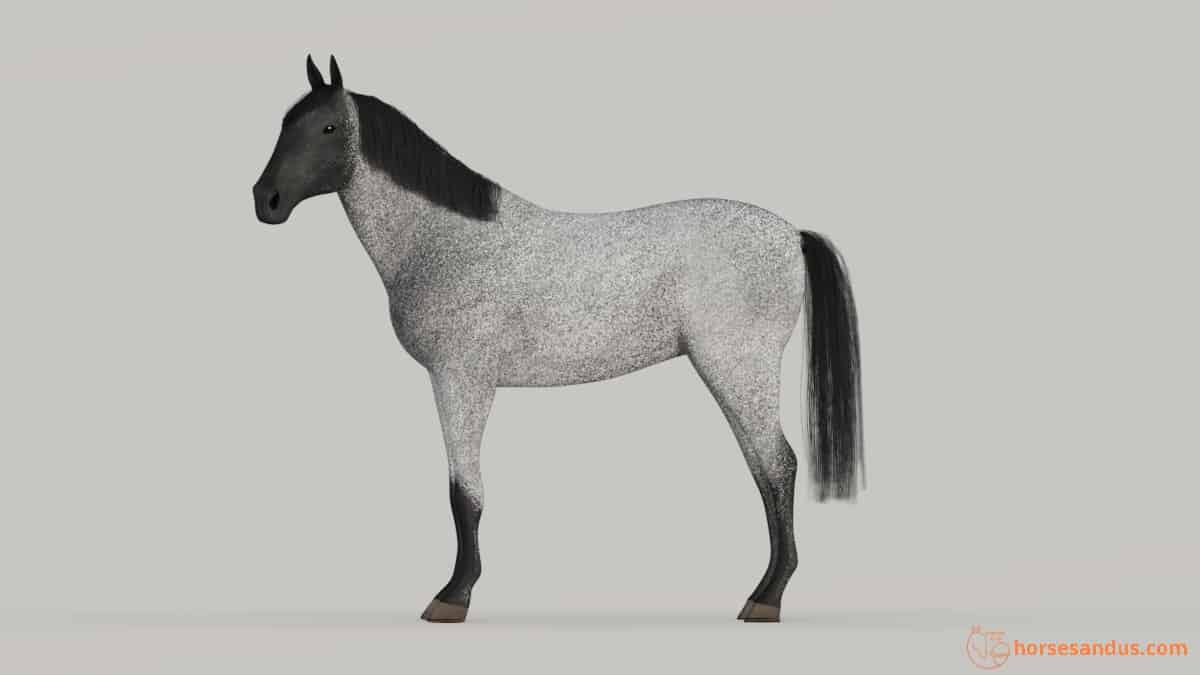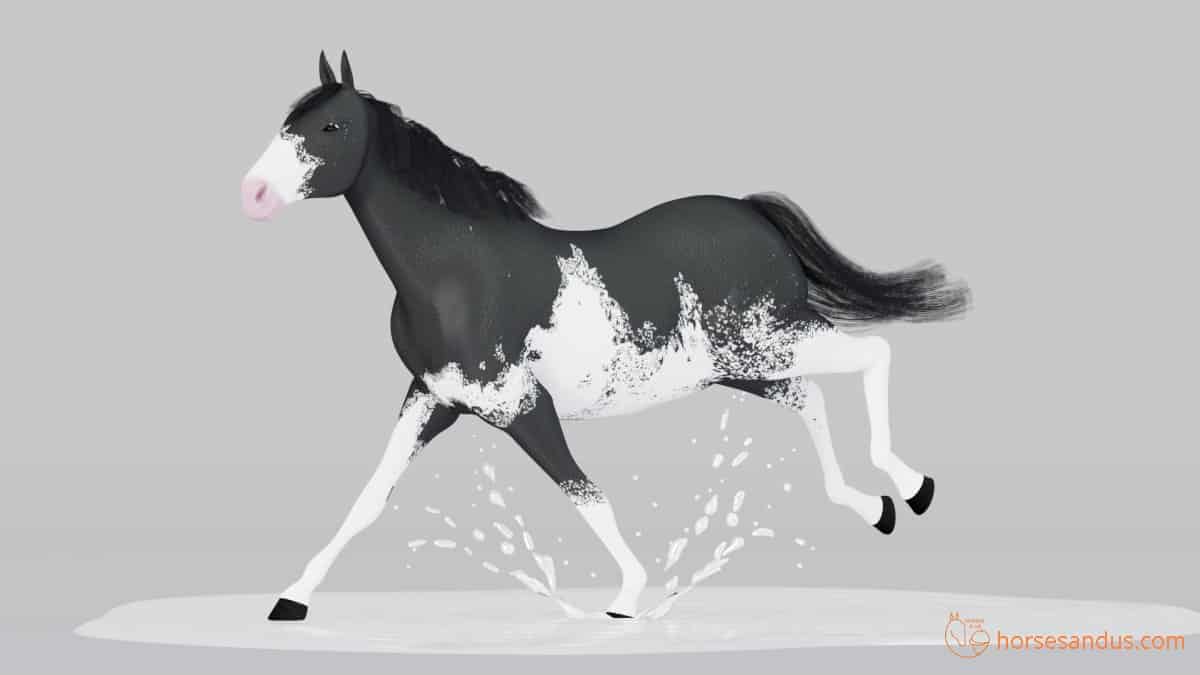A Splashed White horse has the appearance of a horse that has been dipped in white paint. It is characterized by white legs and a large blaze on the face. It will also usually have white markings, horizontally distributed across the lower body (neck, thorax, and belly), which rarely reach the topline.
The white markings have crisp borders without any speckling or roaning. The area covered with the white spotting can vary from minimal to extensive.
Splashed White is a pattern from the Overo Family, and sometimes it is referred to as Overo instead of the more specific Splashed White designation.
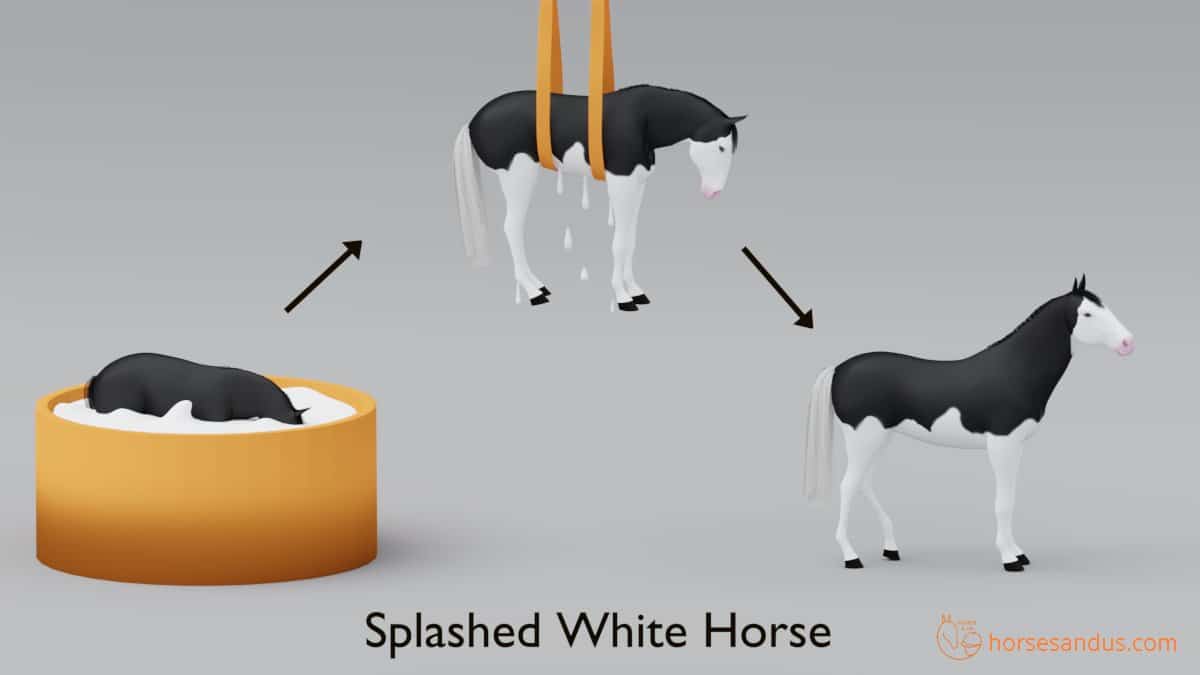
There is a huge variety of horse colors and patterns. In this article, we will look at the patterns produced by the Splashed White gene.
Characteristics Of Splashed White Horses
The following characteristics will help you identify a Splashed White horse
- The white patches have margins that are smooth and well-defined (without speckling or roaning). The white areas typically do not reach the topline.
- The skin is pink beneath the white patches and dark beneath the colored areas.
- All four legs are white.
- The tail is usually white or white-tipped.
- The face has a wide blaze, often wider on the lower part of the face.
- These horses will usually have blue eyes, even if they do not have white around the eyes. But they may also be brown.
- The mane is usually colored.
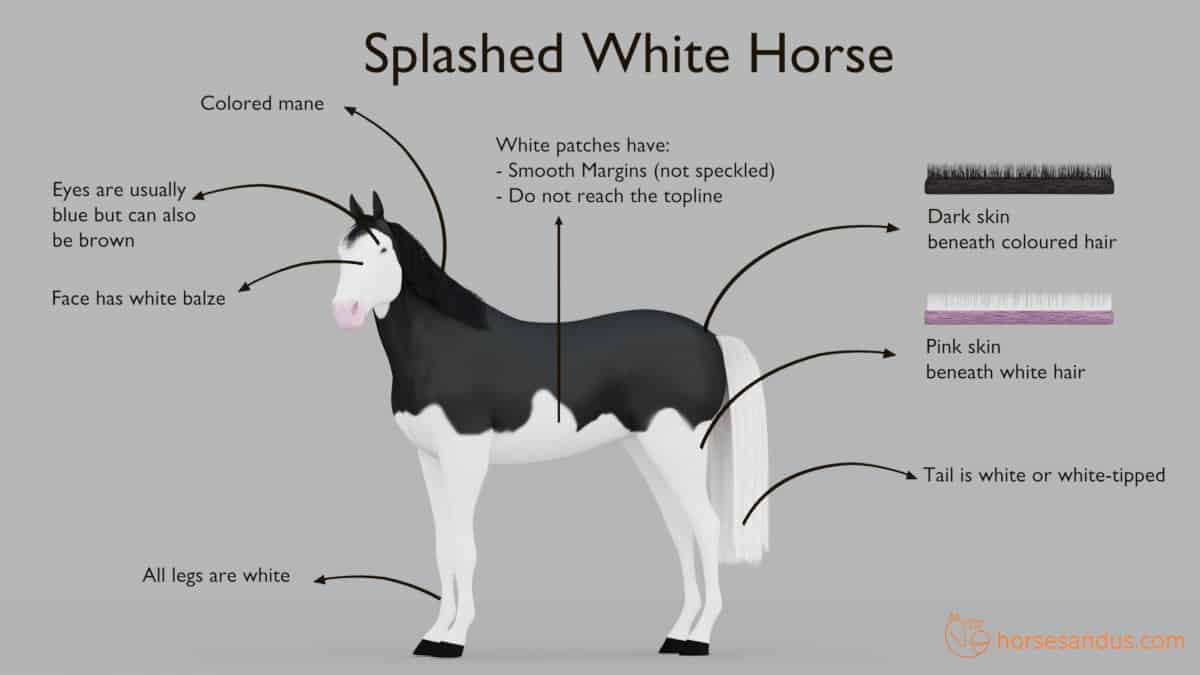
The Splashed White can occur with any base coat color (black, chestnut, bay) or diluted coat color (dun, cream, silver, and champagne).
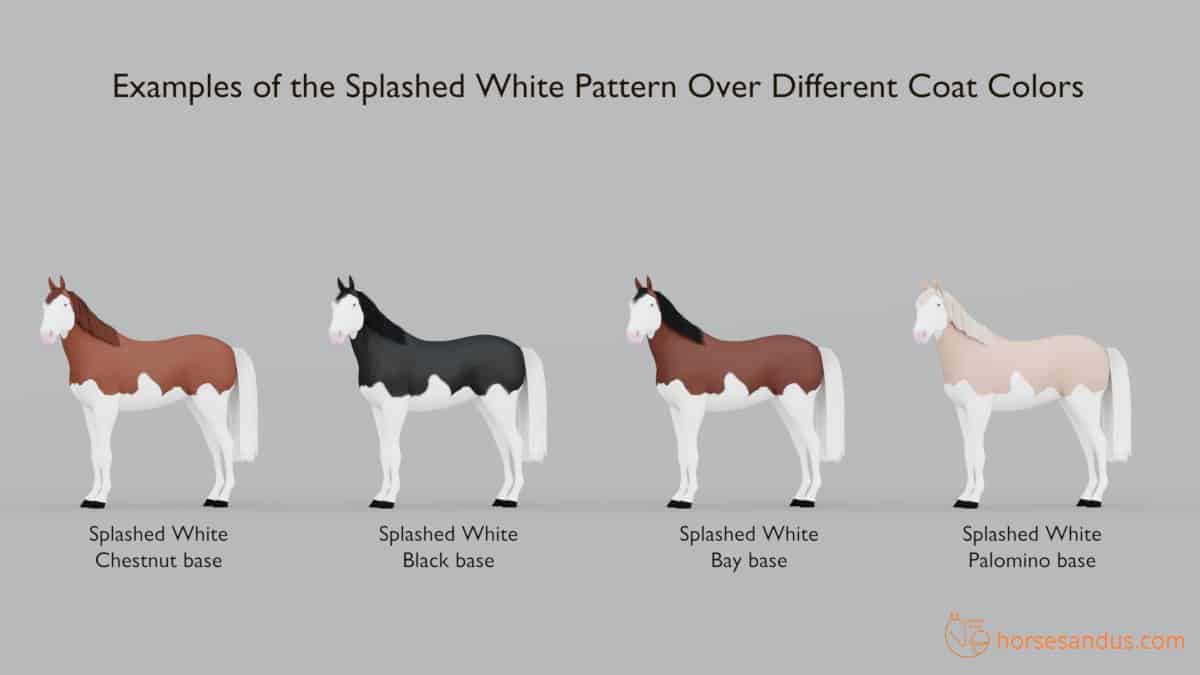
It can also exist in conjunction with other white patterns (Frame, Sabino, Tobiano, Dominant White, Leopard Complex, or Roan).
Splashed White horses can also progressively whiten as they age due to the action of the Grey gene.
Variability Of The Splashed White Pattern
Like other white patterns, the expression of the Splashed white pattern can vary a lot.
It can range from minimal (small areas of white) to extensive (large areas of white)
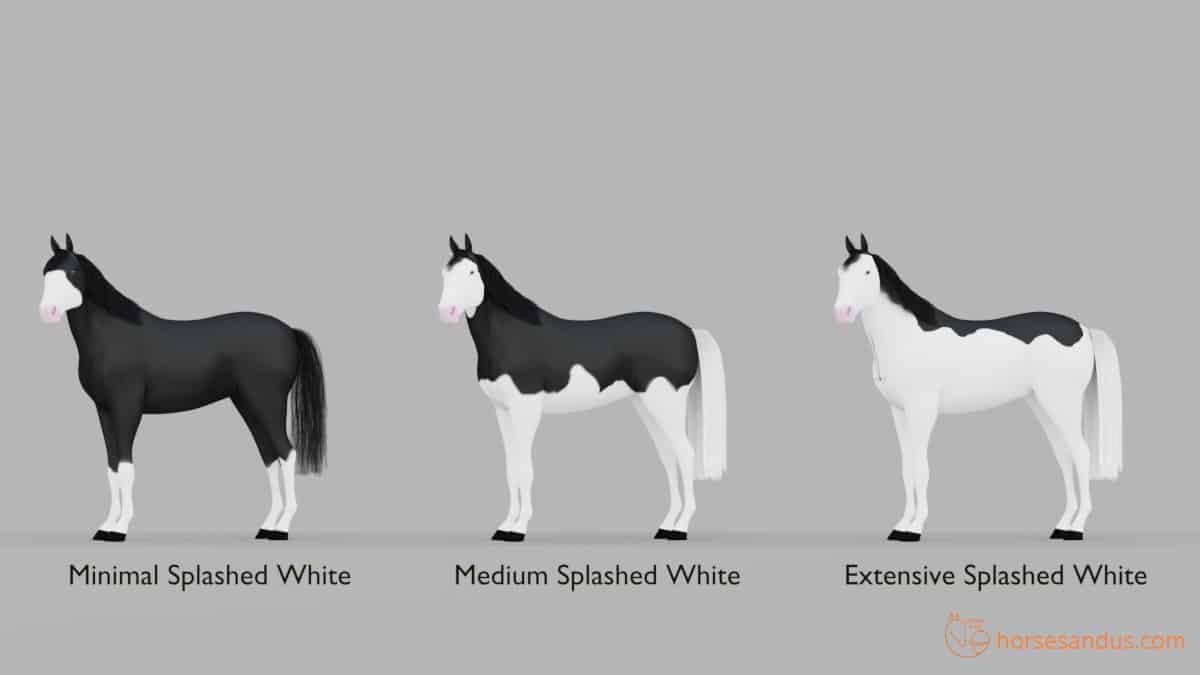
Minimal Splashed white: can have almost no white areas, except for some markings on the face and legs. This makes it difficult to visually distinguish from the “common” white markings seen in colored horses.
Medium Splashed white: the pattern with medium expression is quite easy to identify because it will show this pattern’s characteristic spotting.
Extensive Splashed White: are almost completely white, except for the ears and the topline, where the white rarely touches.
Other Names Used For Splashed White Horses
The patterns of the Splashed White horses are often referred to by other names.
Piebald and Skewbald
Piebald and skewbald are both terms often used to describe white patterns on a colored horse. These terms apply to Splashed White since it is a white pattern.
Piebald is a horse with white patterns on a black base coat.
Skewbald is a horse with white patterns on a non-black coat, such as chestnut, bay, palomino, buckskin, dun, and so on. That is, on any coat color (base or diluted) other than black. A skewbald on a bay coat is also called tricolored because there are three colors: white, brown, and black.
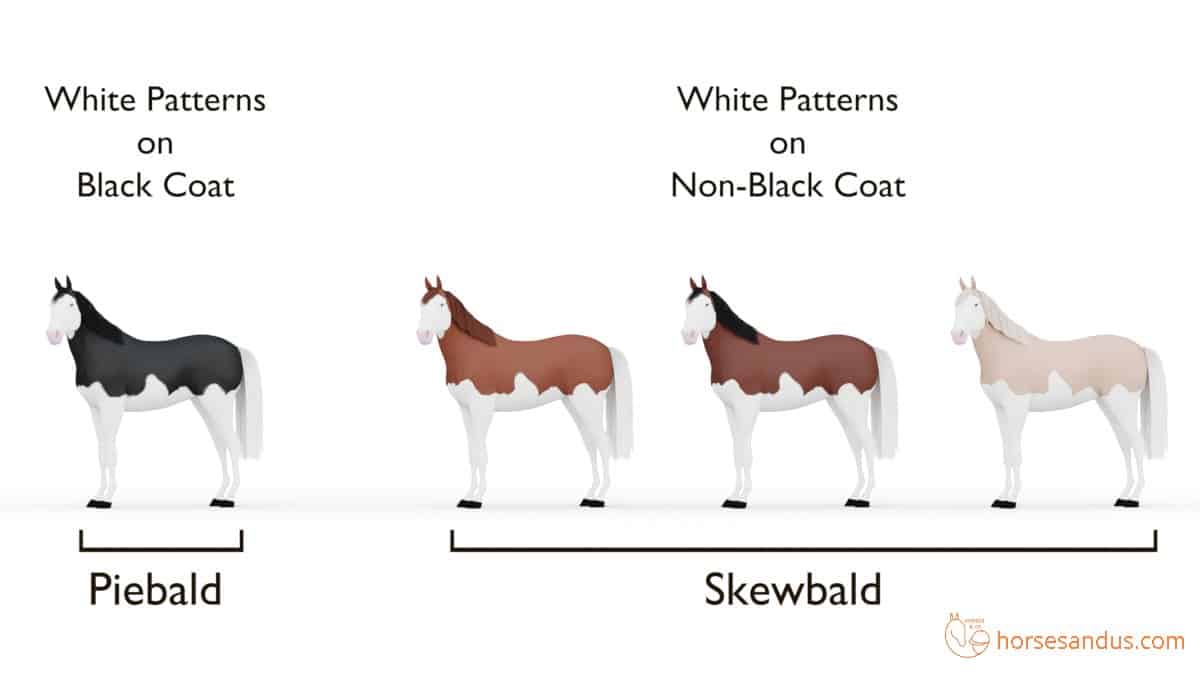
Pinto and Paint
Both Pinto and Paint refer to horses with white patterns and any other color (black, bay, chestnut, or any dilution like, for example, palomino).
The difference is that a Pinto horse can be from any breed, whereas a Paint horse refers to a specific breed with this name.
Similarities And Coexistence With Other White Patterns
It is not always possible to visually identify if the horse is Splashed White, especially in the following situations:
Similarities
Splashed white pattern is similar to Sabino. They both have white feet and faces, however, splashed white horses have white areas with smooth well defined edges, whereas sabino horses have rough roan edges.
Nevertheless, splashed white horses can be confused with the Sabino horses that have less roan in their patterns.
They can also be confused with Frame Overo horses, when these have white marks on the legs.
The most usual pattern of Splashed white resembles an “inverted Tobiano”
Coexistence
The Splashed White can also occur in conjunction with other white patterns, making it sometimes impossible to identify.
When more than one white pattern exist together, the extension of white areas is larger due to the additive effect of the white pattern genes.
In these cases, DNA testing is the only way to determine if the horse carries the Splashed white gene.
The Genes Behind The Splashed White
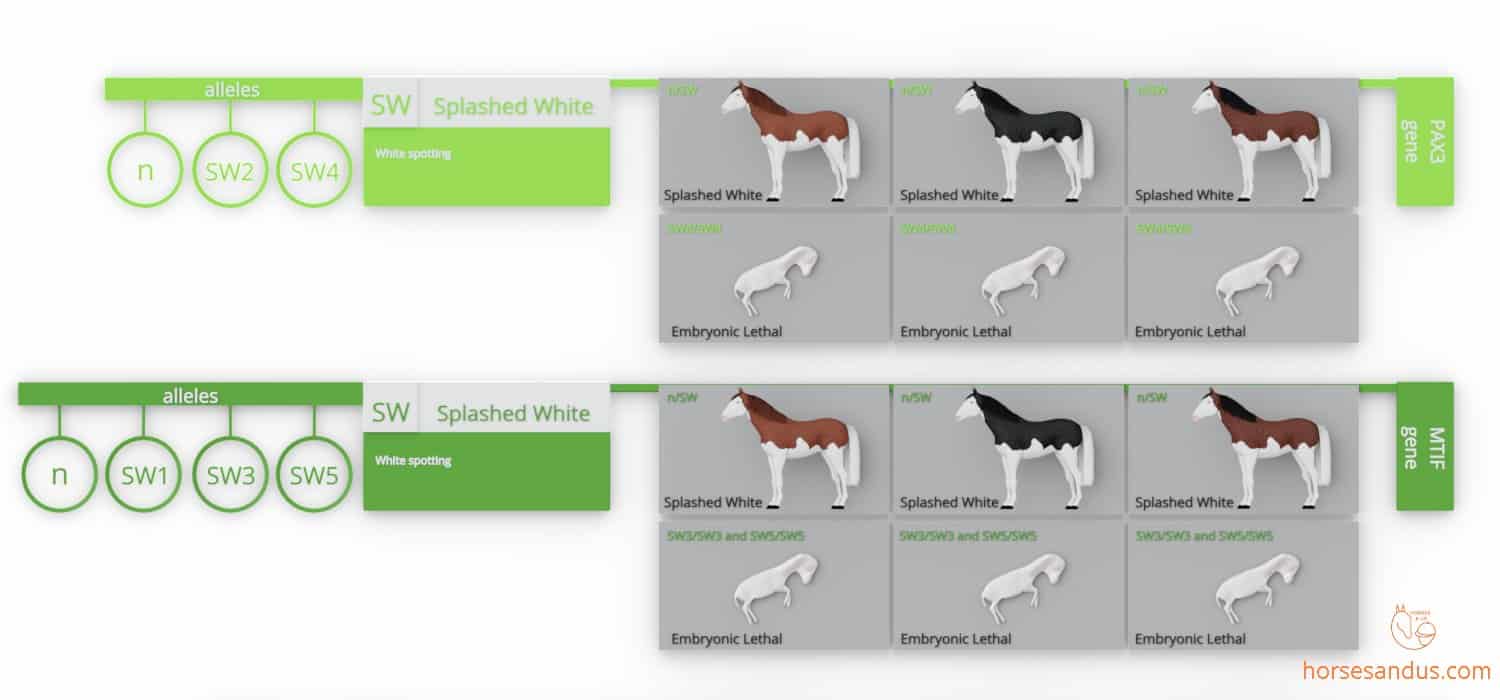
There are two genes responsible for the production of Splashed white:
- MITF on chromosome 16
- PAX3 on chromosome 6

It is quite confusing to have the same name, Splashed White, for two different genes. They should have been given two different names.
Five mutations have been identified. These are SW1, SW2, SW3, SW4, SW5. All of these mutations cause a similar phenotype, although the amount of white pattern is variable.
- SW1, SW3, and SW5 are mutations in the MITF gene
- SW2 and SW4 are mutations in the PAX3 gene.
All of these mutations (SW1, SW2, SW3, SW4, SW5) are dominant, which means that only one allele needs to be present to express the Splashed White trait. However, this trait’s expression can be very different, varying from minimal white markings to extensive white areas that cover most of the body.
Because Splashed White mutations are found in two separate genes (MITF and PAX3), a horse can have more than two Splashed White alleles. It can have up to four, two from MITF and another two from PAX3.
When mutations from both genes are present, the horse will display a pattern with an extensive white area.
It may seem confusing that a horse can have more than two alleles of the same white pattern, but this is just the consequence of the same name (Splashed White) being given to two different genes.
Think of it as being two layers of different white pattern genes. Like for example Overo + Tobiano, or Splashed White + Sabino… and so on. In this case, it is Splashed white (from MITF gene) + Splashed white (from PAX3 gene).
Splashed White genes inheritance

There are many possible combinations of mutations from these two genes, but most of them will probably never occur.
A foal can inherit up to 4 Splashed White alleles from its parents. (two from the Sire and two from the Dam)
There are some possible combinations within each gene that have never been identified and are therefore considered embryonic lethal. These combinations are the homozygous states:
- SW3/SW3
- SW4/SW4
- SW5/SW5.
Breeds Where We Can Find The Splashed White Pattern
The different alleles of the splashed white genes can be found in different breeds.
SW1 (MITF)
- This is the most common splashed white variant. It may be several hundred years old. This allele can exist in many breeds, namely Quarter Horse, Appaloosa, Paint Horse, Morgan Horse, Trakehner, Miniature Horse, Shetland Pony, and Icelandic Horse – and may be present in other breeds as well.
SW2 (PAX3)
- This variant is only found in certain lines of Quarter Horses and Paint Horses which are all descendants from a single Quarter horse Mare born in 1987. SW2 is currently not considered to be homozygous lethal, however, horses that have SW2 may be deaf.
SW3 (MITF)
- This variant is very rare and occurs exclusively in certain lines of Quarter Horses and Paint Horses. SW3 is thought to be lethal in the homozygous state (SW3/SW3) as no individuals with this genotype have yet been identified.
SW4 (PAX3)
- This variant is a rare mutation and has been identified in a family of Appaloosa horses. SW4 is thought to be lethal in the homozygous state (SW4/SW4) as no individuals with this genotype have yet been identified.
SW5 (MITF)
- This variant is very rare and was identified in a Paint Horse family. SW5 is thought to be lethal in the homozygous state (SW5/SW5) as no individuals with this genotype have yet been identified.
Health Issues Associated With The Splashed White Genes
Splashed white horses may have some health issues that are caused by the splashed white genes.
Deafness
Some white splashed horses are deaf. There seems to be a relation between this pattern and deafness when the inner ear is not pigmented. The absence of pigment in the inner ear is associated with the death of hair cells, which are necessary for detecting sound.
Embryonic Lethal
It is believed that the homozygous state for SW3, SW4, and SW5 mutations may be embryonic lethal because none of these homozygous states have ever been identified.
Therefore breeders should avoid the mating of horses that could produce any of these homozygous states. Especially the breeders of Paint, Quarter, and Appaloosa horses, where these alleles may exist.
However, this is not easy to predict because just observing the white markings cannot indicate which alleles are present.
The safest way to prevent the outcome of an embryonic lethal is to perform a DNA test for these genes on the horses that are planned to be mated.
Commercially available genetic tests can easily detect the Splashed White gene and therefore identify the carriers.
Problems associated with Pink Skin
The pink skin that is present in Splashed White horses will be extra sensitive to sun exposure, due to the lack of protective pigment.
The pink skin of white horses does not have melanin and therefore is not protected when it is exposed to sunlight. This leaves the skin at the mercy of UV rays and vulnerable to damage.
This is not simply a sunburn; it may cause skin lesions. These lesions present redness, swelling, and itching. Subsequent infections may occur, followed by necrosis and shedding of skin. Cancer of the skin may also develop.
You may want to try the Summer Care Butter to protect your horse´s skin from sunburn. This product can be purchased at Amazon.
The link below that leads to a product on Amazon is an affiliate link and I earn a commission (with no additional cost for you) if you make a purchase.
The Blissful Horses Summer Care Butter All Natural Sun Support for Your Horse, 4-OunceFurther Reading
If you would like to learn more about horse colors and white patterns, you may want to read the following books, available on amazon.
The links below that lead to products on Amazon are affiliate links and I earn a commission (with no additional cost for you) if you make a purchase.
These books are an introduction to horse colors and white patterns which are full of images and very easy to understand.
The Equine Tapestry: An Introduction to Colors and Patterns The Ultimate Guide to Horse ColorsA more technical book about horse colors, but still very easy to understand.
Equine Color GeneticsSources
https://www.ncbi.nlm.nih.gov/pubmed/22511888?dopt=Abstract
Equine Color Genetics 4th Edition by D- Philip Sponenberg
